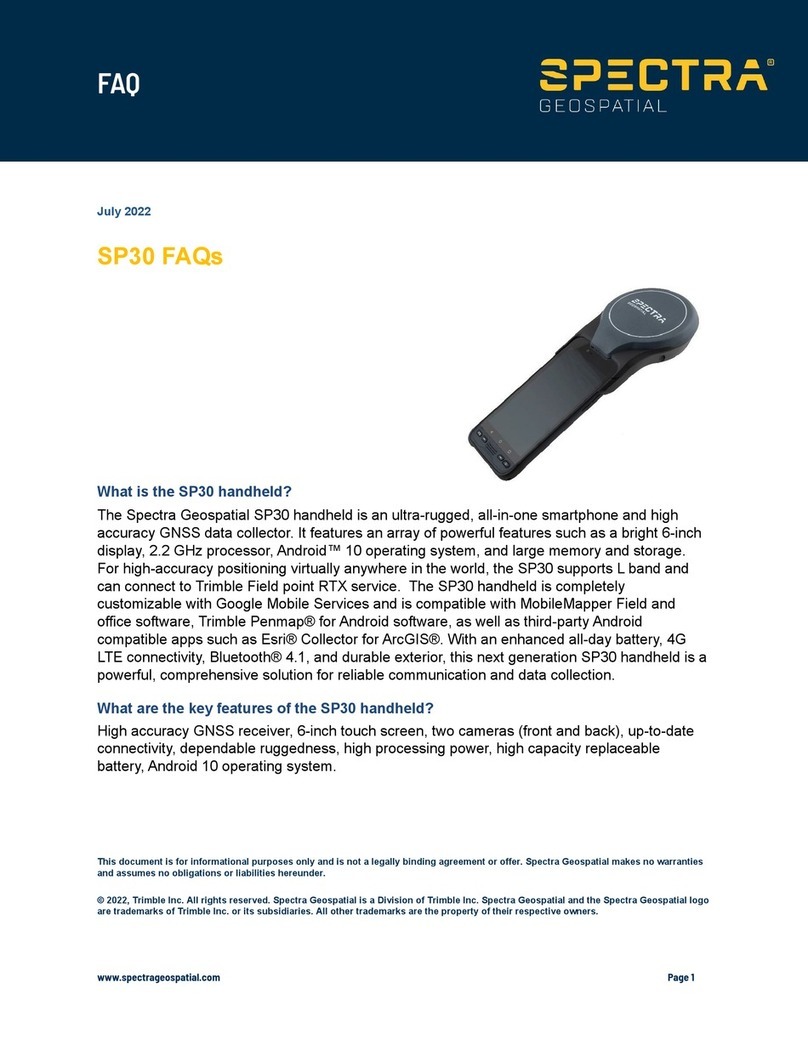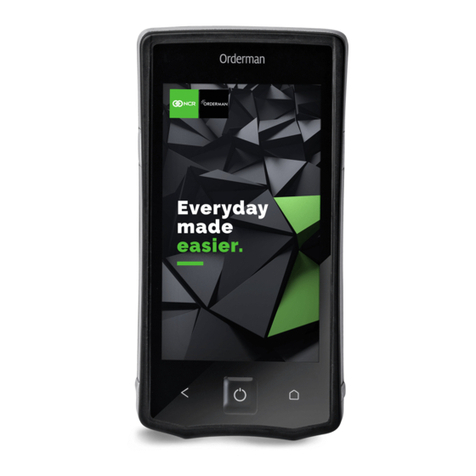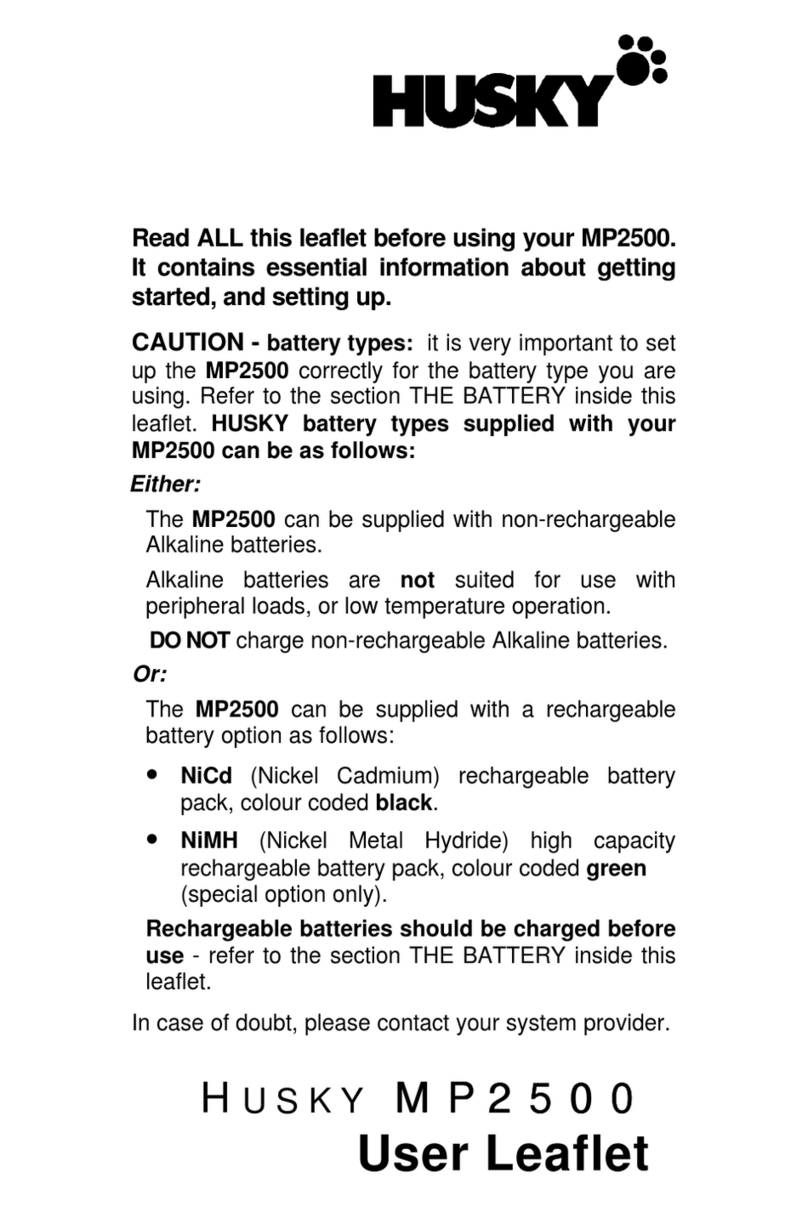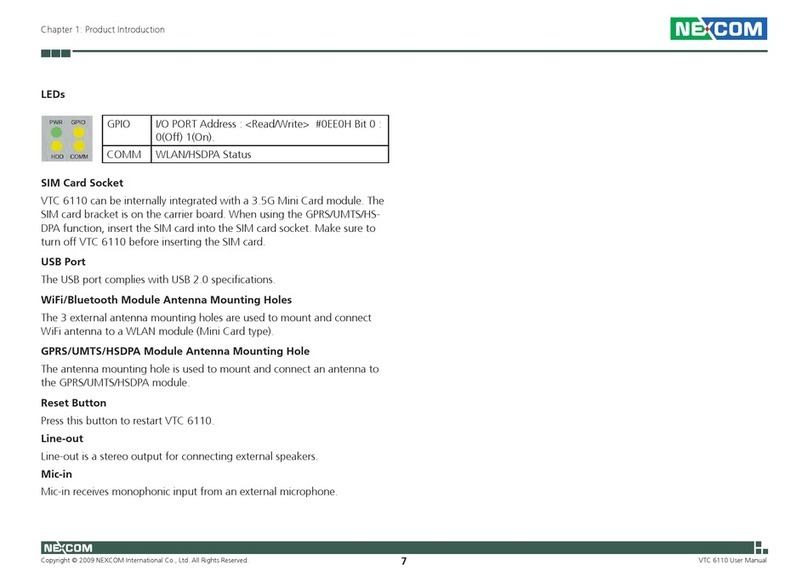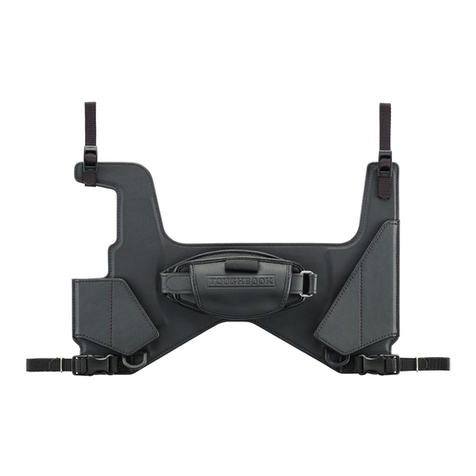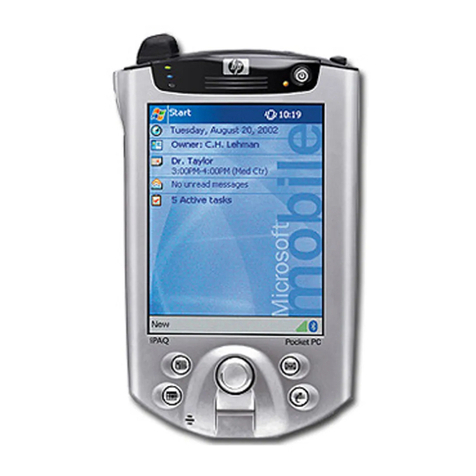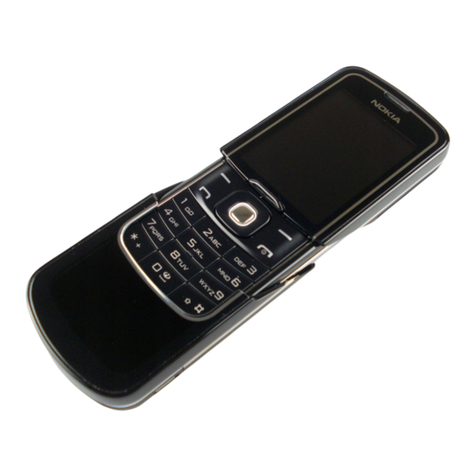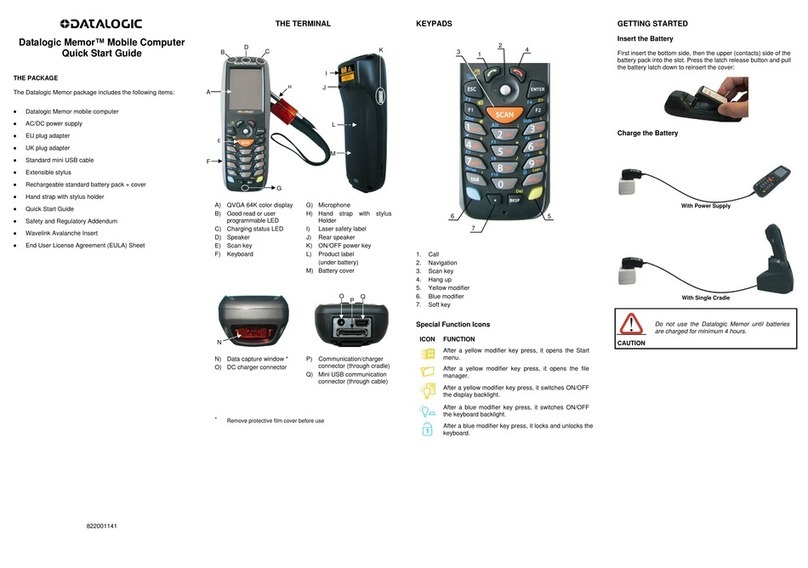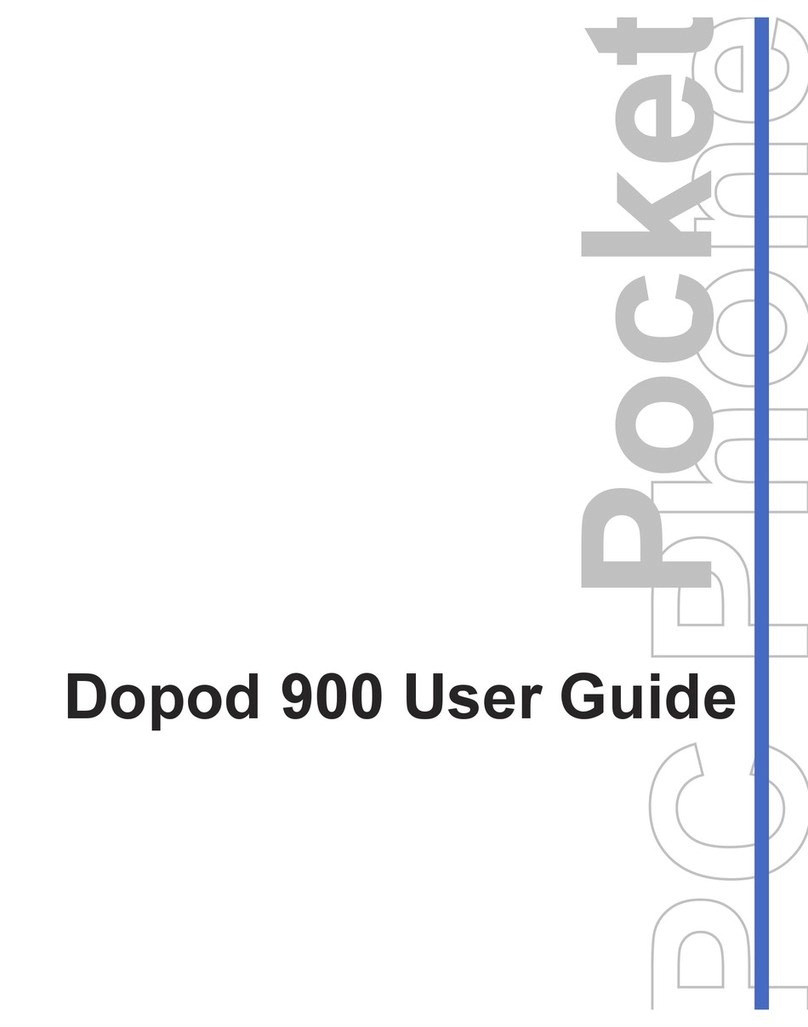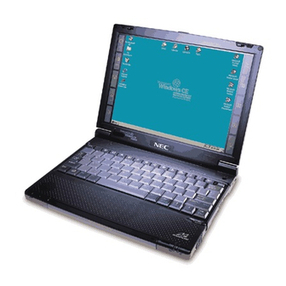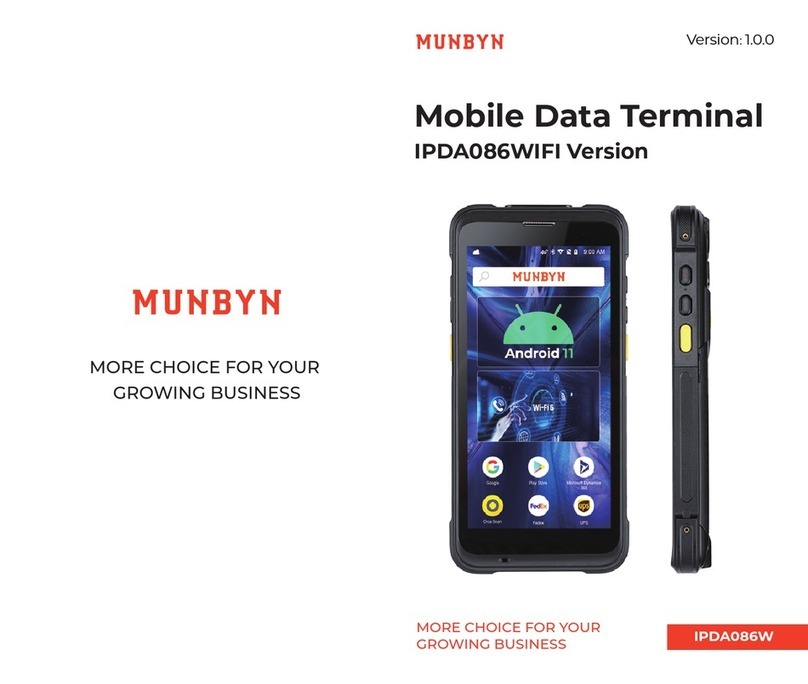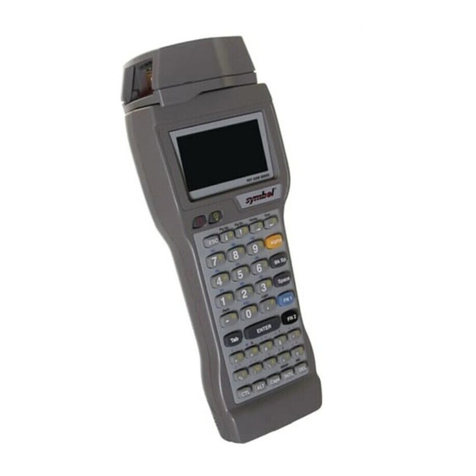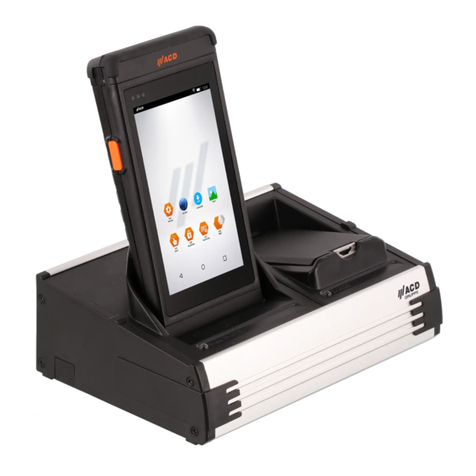Spectra Geospatial MobileMapper 60 User manual

MobileMapper 60 Handheld
User Guide

Corporate Office
Trimble Inc.
10368 Westmoor Drive
Westminster, CO 80021
USA
www.spectrageospatial.com
Legal Notices
© 2019, Trimble Inc. All rights reserved. Spectra Geospatial is a
Division of Trimble Inc. Spectra Geospatial and the Spectra Geospatial
logo are trademarks of Trimble Inc.
The Bluetooth word mark and logos are owned by the Bluetooth SIG,
Inc. and any use of such marks by Trimble Inc. is under license.
Google, Google Play and other marks are trademarks of Google LLC.
All other trademarks are the property of their respective owners.
Release Notice
This is the June 2019 release (Revision A) of the MobileMapper 60
handheld documentation. It applies to the Android operating system
8.0.
Limited Warranty Terms and Conditions
Product Limited Warranty. Subject to the terms and conditions set
forth herein, Trimble Inc. (“Trimble”) warrants that for a period of
three (3) years from date of purchase this Trimble product (the
“Product”) will substantially conform to our publicly available
specifications for the Product and that the hardware and any storage
media components of the Product will be substantially free from
defects in materials and workmanship.
Warranty Remedies. If the Product fails during the warranty period
for reasons covered by this limited warranty and you notify us of such
failure during the warranty period, we will repair OR replace the
nonconforming Product with new, equivalent to new, or reconditioned
parts or Product, OR refund the Product purchase price paid by you, at
our option, upon your return of the Product in accordance with our
product returnprocedures then in effect.
Official Language
THE OFFICIAL LANGUAGE OF THESE TERMS AND CONDITIONS IS
ENGLISH. IN THE EVENT OF A CONFLICT BETWEEN ENGLISH AND
OTHER LANGUAGE VERSIONS, THE ENGLISH LANGUAGE SHALL
APPLY.
USA
Supplier's Declaration of Conformity
We, Trimble Inc, declare under sole responsibility that the product:
MobileMapper 60 handheld complies with Part 15 of FCC Rules.
Operation is subject to the following two conditions: (1) this device
may not cause harmful interference, (2) and this device must
accept any interference received, including interference that may
cause undesired operation.
Trimble Inc.
10368 Westmoor Drive
Westminster, CO 80021
Notices
Class B Statement - Notice to Users. This equipment has been tested
and found to comply with the limits for a Class B digital device,
pursuant to Part 15 of the FCC Rules. These limits are designed to
provide reasonable protection against harmful interference in a
residential installation. This equipment generates, uses and can
radiate radio frequency energy and, if not installed and used in
accordance with the instructions, may cause harmful interference to
radio communication. However, there is no guarantee that
interference will not occur in a particular installation. If this equipment
does cause harmful interference to radio or television reception,
which can be determined by turning the equipment off and on, the user
is encouraged to try to correct the interference by one or more of the
following measures:
- Reorient or relocate the receiving antenna.
- Increase the separation between the equipment and the receiver.
- Connect the equipment into an outlet on a circuit different from that
to which the receiver is connected.
- Consult the dealer or an experienced radio/TV technician for help.
Changes or modifications not expressly approved by the
manufacturer or registrant of this equipment can void your authority
to operate this equipment under Federal Communications
Commission rules.
Spectra Geospatial MobileMapper 60 Handheld User Guide | 2

Canada
The digital apparatus does not exceed the Class B limits for radio
noise emissions from digital apparatus as set out in the radio
interference regulations of the Canadian Department of
Communications.
Le présent appareil numérique n’émet pas de bruits radioélectriques
dépassant les limites applicables aux appareils numériques de Classe
B prescrites dans le règlement sur le brouillage radioélectrique édicté
par le Ministère des Communications du Canada.
This device contains licence-exempt transmitter(s)/receiver(s) that
comply with Innovation, Science and Economic Development Canada’s
licence-exempt RSS(s). Operation is subject to the following two
conditions: (1) This device may not cause interference. (2) This device
must accept any interference, including interference that may cause
undesired operation of the device.
Le présent appareil est conforme CNR d'industrie Canada applicables
aux appareils radio exempts de licence. L'exploitation est autorisée
aux deux conditions suivantes: (1) il ne doit pas produire de brouillage,
et (2) l'utilisateur du dispositif doit être prêt a accepter tout brouillage
radioélectrique recu, même si ce brouillage est susceptible de
compromettre le fonctionnement du dispositif.
Europe
Hereby, Trimble, declares that the MobileMapper 60
handheld is in compliance with the following directives:
- RED 2014/53/EU
- RoHS Directive 2011/65/EU.
The products covered by this guide may be operated in all EU member
countries (BE, BG, CZ, DK, DE, EE, IE, EL, ES, FR, HR, IT, CY, LV, LT, LU,
HU, MT, NL, AT, PL, PT, RO, SI, SK, FI, SE, UK), Norway, and Switzerland.
Information about included radio modules:
- Bluetooth radio: BT4.1 dual role (BT/BLE), Frequency band 2402-
2480MHz, max RF radiated output power +8dBm.
- Wi-Fi radio:
- 802.11bgn, Frequency band 2400-2496 MHz
- IEEE802.11a/b/g/n/ac, Frequency bands 2400-2496 MHz and
5150-5825 MHz (depending on country)
- max RF radiated output power +15 dBm.
- 2G/3G/4G cell radio:
- Frequency bands (2G) 850/900/1800/1900 MHz.
- Frequency bands (3G) 850/900/1900/2100 MHz.
- Frequency bands (4G) FDD B1 (2100) / B2 (1900) / B3 (1800) / B4
(1700) / B5 (850) /B7 (2600) / B8 (900) / B12/B13/B17/B28 (700) / B20
(800 MHz) / B25 (1900 MHz).
- Frequency bands (4G) TDD B38 (2600) / B39 (1900) / B40
(2300) / B41 (2500 MHz).
- Max RF radiated output power +34 dBm.
European Union Customers: WEEE
Recycling in Europe: To recycle Trimble WEEE (Waste
Electrical and Electronic Equipment products that run
on electric power), call +31 497 53 24 30 and ask for the
“WEEE Associate”. Or, mail a request for recycling instructions to:
Trimble Europe BV
c/o Menlo Worldwide Logistics
Meerheide 45
5521 DZ Eersel, NL
Spectra Geospatial MobileMapper 60 Handheld User Guide | 3

Spectra Geospatial MobileMapper 60 Handheld User Guide | 4

Contents
Safety information 7
Radio use 7
Exposure to Radio Frequency (RF) Signals 8
Exposure to radio frequency radiation from Bluetooth and WLAN transmitters 8
Exposure to radio frequency radiation from cellular wireless transmitters 8
Telecommunications & Internet Association (TIA) information 9
ACadaptor safety 9
Battery safety 10
Electrostatic discharge 11
Storage card use 11
Exposure to loud audio 12
1 Getting started 13
Introduction 14
Registration 14
Technical assistance 14
Additional help 15
Use and care of the handheld 15
Parts of the MobileMapper 60 handheld 17
Accessories 18
Powering the handheld 18
Charging the battery 18
Turning the handheld on and off 19
Checking the level of battery power 19
Conserving power 19
Storing data 19
Memory cards 20
Inserting and removing a SIM card and SDcard 20
Attaching the handstrap 22
Assigning apps to the programmable buttons 22
Resetting the handheld 23
Calibrating the compass 23
Connecting to an office computer 23
2 Using the Android operating system 24
Using the Home screen(s) 25
Interacting with the handheld 25
Entering information 27
Using the menus 27
Using the on-screen keyboard 27
Editing text 28
Managing notifications 28
Selecting the language 29
Spectra Geospatial MobileMapper 60 Handheld User Guide | 5

Contents
Setting the time and date 29
Using the clock to set alarms 29
Display settings 30
Sounds and notifications 30
Locking the device 30
Sending and receiving email 31
3 Using the Wi-Fi (WLAN) and Bluetooth radios 32
Turning on and turning off the Wi-Fi (WLAN)and Bluetooth radios 33
Connecting to a Wi-Fi (WLAN) access point 33
Adding a Wi-Fi network 34
Forgetting a Wi-Fi network 34
Advanced Wi-Fi settings 34
Connecting to a Bluetooth-enabled device 34
Working with paired Bluetooth-enabled devices 35
Unpairing a Bluetooth device 36
Accessing a corporate network 36
4 Using the cellular modem 38
Manually connecting to a cellular network from the modem 39
Switching between SIM card networks 39
Configuring cellular network settings 39
Using the Smartphone 39
Using the Call History log 40
Messaging 41
Sending a text or a multimedia message 41
Deleting message threads 41
Replying to messages 41
Changing Messaging settings 42
5 Using the GNSS receiver 43
Receiving signals from GNSSsatellites 44
Supported software 44
Using an external GNSS antenna 45
Using an external GNSS receiver 45
6 Using the camera 46
Starting and closing the Camera app 47
Using the camera in Still mode 47
Using the camera in Panorama mode 47
Using the camera in Video mode 48
Camera setting options 49
Working with photos and videos in the Android Photos or Gallery app 50
Spectra Geospatial MobileMapper 60 Handheld User Guide | 6

Safety information
Safety information
Radio use
Telecommunications & Internet Association (TIA) information
Battery safety
ACadaptor safety
Electrostatic discharge
Storage card use
Exposure to loud audio
Radio use
Radio use
The MobileMapper 60 handheld contains a Bluetooth® radio, a WLAN (Wi-Fi) radio, and a 4G cellular
modem radio. In some situations, you may be required to turn off the radios. For example, aviation
authority regulations restrict the use of wireless transmission devices on board aircraft.
To prevent the handheld from emitting radio signals, do one of the following:
lTo put the handheld in airplane mode, press and hold the Power button for two seconds to display
the Power options menu, then tap Airplane mode. This mode turns off all wireless connections.
lTo turn off the handheld, press and hold the Power button for two seconds to display the Power
options menu, then tap Power off.
lTo turn off any of the Bluetooth, Wi-Fi , and wireless cellular modem radios, on the Home screen, tap
Settings, then:
lUnder Network & Internet, tap the Wi-Fi and / or Mobile network sliders to turn them off.
lUnder Connected devices, tap Bluetooth to turn it off.
NOTE – You may need to deactivate the Wi-Fi and/or Bluetooth radio in the handheld if the country in
which you are working does not approve the use of Wi-Fi and/or Bluetooth wireless technology. If you are
unsure about whether the handheld’s radios are approved for use in your country, check with your
Spectra Geospatial reseller.
Spectra Geospatial MobileMapper 60 Handheld User Guide | 7

Safety information
Exposure to Radio Frequency (RF) Signals
Your device contains a radio transmitter and receiver. The radiated output power is far below the
international radio frequency exposure limits. These limits are part of comprehensive guidelines and
establish permitted levels of RF energy for the general population. The guidelines are based on the
safety standards previously set by international standards bodies:
lAmerican National Standards Institute (ANSI) IEEE. C95.1-1992.
lNational Council on Radiation Protection and Measurement (NCRP). Report 86. 1986.
lInt’l Commission on Non-Ionizing Radiation Protection (ICNIRP) 1996.
lMinistry of Health (Canada), Safety Code 6. The standards include a substantial safety margin
designed to assure the safety of all persons, regardless of age and health.
SAR: 0.545w/kg
Use of unauthorized or modified antennas may impair call quality and damage the device, causing loss of
performance. To assure optimal performance and ensure human exposure to RF energy is within the
guidelines set forth in the relevant standards; always use your device only in its normal-use position.
Avoiding contact with the antenna area when the device is IN USE optimizes the antenna performance.
Exposure to radio frequency radiation from Bluetooth and WLAN
transmitters
This device is approved as a portable device with respect to Radio Frequency (RF) exposure compliance.
The radiated output power of the internal wireless radio transmitters is less than 100 milliwatt, which
results in exposure levels far below the FCC radio frequency exposure limits, even when operated in close
proximity to the body. The internal wireless radios operate within guidelines found in international radio
frequency safety standards and recommendations, which reflect the consensus of the international
scientific community. Spectra Geospatial therefore believes the internal wireless radios are safe for use
by users. The level of electromagnetic energy emitted is hundreds of times lower than the
electromagnetic energy emitted by wireless devices such as mobile phones. However, the use of wireless
radios may be restricted in some situations or environments, such as on aircraft. If you are unsure of
restrictions, you are encouraged to ask for authorization before turning on the wireless radios.
Exposure to radio frequency radiation from cellular wireless
transmitters
Devices equipped with wireless cellular modem radios have been designed and manufactured to meet
safety requirements for limiting exposure to radio waves. When used in accordance with the instructions
set forth in this manual, the equipment has been independently verified to not exceed the emission limits
for safe exposure to radio frequency (RF) energy as specified by the Federal Communications
Commission of the U.S. Government in 47 CFR §2.1093. These limits are part of comprehensive guidelines
and establish permitted levels of RF energy for the general population. The guidelines are based on
standards that were developed by independent scientific organization through periodic and thorough
Spectra Geospatial MobileMapper 60 Handheld User Guide | 8

Safety information
evaluation of scientific studies. The standards include a substantial safety margin designed to assure
the safety of all persons, regardless of age and health.
Telecommunications & Internet Association (TIA)
information
Hearing Aids: Some digital wireless phones may interfere with some hearing aids. In the event of such
interference, you may want to consult your wireless service provider, or call customer service to discuss
alternatives.
Pacemakers and Other Medical Devices: The Health Industry Manufacturers Association recommends a
minimum separation of six inches be maintained between a handheld wireless phone and a pacemaker to
avoid potential interference with the pacemaker. These recommendations are consistent with the
independent research by and recommendations of Wireless Technology Research. Persons with
pacemakers should use the ear opposite the pacemaker to minimize the potential for interference.
Persons with pacemakers should exercise great caution if using a hands-free device such as a headset,
as these persons may be at greater risk of the device not maintaining the recommended minimum six
inches of separation from the pacemaker. If you have any reason to suspect that interference is taking
place, turn the device OFF immediately.
If you use any other personal medical device, consult the manufacturer of your device to determine if
they are adequately shielded from external RF energy. Your physician may be able to assist you in
obtaining this information.
Turn the device OFF in health care facilities when any regulations posted in these areas instruct you to
do so. Hospitals or health care facilities may be using equipment that could be sensitive to external RF
energy.
ACadaptor safety
To charge the handheld’s battery, use the USB cable and adaptor kit provided with the handheld (see
Powering the handheld, page 18).
WARNING – To use ACadaptors safely:
lUse only the AC adaptor intended for the handheld. Using any other AC adaptor can damage the
handheld and may void your warranty. Do not use the AC adaptor with any other product.
lMake certain that the input voltage on the adaptor matches the voltage and frequency in your
location.
lMake certain that the adaptor has prongs compatible with your outlets.
lDo not use the AC adaptor in wet outdoor areas; it is designed for indoor use only.
lUnplug the AC adaptor from power when not in use.
Spectra Geospatial MobileMapper 60 Handheld User Guide | 9

Safety information
Battery safety
The rechargeable Lithium-ion battery is supplied partially charged. Charge the battery completely
before using it for the first time (see Powering the handheld, page 18). If the battery has been stored for
longer than six months, charge it before use.
WARNING – Use only the battery intended for the product. Using any other battery can damage
the handheld and may void your warranty. If the battery becomes damaged or stops charging fully,
replace it with a new battery.
WARNING – Charge and use the rechargeable Lithium-ion battery only in strict accordance with
the instructions. Charging or using the battery in unauthorized equipment can cause an explosion or
fire, and can result in personal injury and/or equipment damage. To prevent injury or damage:
lDo not charge or use the battery if it appears to be damaged or leaking.
lCharge the Lithium-ion battery only in a product that is specified to charge it. Be sure to follow
all instructions that are provided with the battery charger.
lDiscontinue charging a battery that gives off extreme heat or a burning odor.
lUse the battery only in equipment that is specified to use it.
lUse the battery only for its intended use and according to the instructions in the product
documentation.
WARNING – Avoid contact with the rechargeable Lithium-ion battery if it appears to be leaking.
Battery fluid is corrosive, and contact with it can result in personal injury and/or property damage.
To prevent injury or damage:
lIf the battery leaks, avoid contact with the battery fluid.
lIf battery fluid gets into your eyes, immediately rinse your eyes with clean water and seek
medical attention. Do not rub your eyes!
lIf battery fluid gets onto your skin or clothing, immediately use clean water to wash off the
battery fluid.
Spectra Geospatial MobileMapper 60 Handheld User Guide | 10

Safety information
WARNING – Do not damage the rechargeable Lithium-ion battery. A damaged battery can
cause an explosion or fire, and can result in personal injury and/or property damage. To prevent
injury or damage:
lDo not use or charge the battery if it appears to be damaged. Signs of damage include, but are
not limited to, discoloration, warping, and leaking battery fluid.
lDo not store or leave your device near a heat source such as near a fireplace or other heat-
generating appliance, or otherwise expose it to temperatures in excess of 70 °C (158 °F) such as
on a vehicle dashboard. When heated to excessive temperatures, battery cells could explode or
vent, posing a risk of fire.
lDo not leave the battery immersed in water.
lDo not use or store the battery inside a vehicle during hot weather.
lDo not drop or puncture the battery.
lDo not open the battery or short-circuit its contacts.
CAUTION – Safe temperature ranges are:
lOperating temperature range: -20 °C to +55 °C (-4 °F to +131 °F).
lStorage temperature range:-40 °C to +70 °C (-40 °F to +158 °F).
Electrostatic discharge
WARNING – Static electricity can harm electronic components inside your handheld. To prevent
static damage, discharge static electricity from your body before you touch any of the electronic
components inside your device, such as a memory module. You can do so by touching an unpainted
metal surface.
The handheld is designed for outdoor conditions; however under conditions of low humidity extremely
high voltage discharge events are possible. Users are advised that the risk of causing discharge to
sensitive electronics can be minimized by avoiding finger contact to the recessed connectors on the
unit.
Storage card use
The handheld provides a storage card slot, providing an alternative storage location to the storage
memory in the handheld.
WARNING – Static electricity can harm electronic components inside your handheld. To prevent
static damage, discharge static electricity from your body before you touch any of the electronic
components inside your device, such as a memory module. You can do so by touching an unpainted
metal surface.
Spectra Geospatial MobileMapper 60 Handheld User Guide | 11

Safety information
Exposure to loud audio
To prevent possible hearing damage, do not listen at high volume levels for long periods.
Spectra Geospatial MobileMapper 60 Handheld User Guide | 12

Getting started
Introduction
Technical assistance
Use and care of the handheld
Parts of the MobileMapper 60 handheld
Accessories
Powering the handheld
Storing data
Inserting and removing a SIM card and SDcard
Attaching the handstrap
Resetting the handheld
Calibrating the compass
Connecting to an office computer
1
Spectra Geospatial MobileMapper 60 Handheld User Guide | 13

1 Getting started
Introduction
This user guide describes how to set up and use the MobileMapper 60 handheld. The information in this
guide supplements the information in the MobileMapper 60 Handheld Quick Start Guide, which you
received with the handheld.
The MobileMapper 60 handheld is powered by the Android™ 8.0 “Oreo” mobile operating system, and is
rated IP67 (see Use and care of the handheld for more information). It has:
lWi-Fi (Wireless LAN) technology
lBluetooth® wireless technology
la high-sensitivity GNSS receiver, supporting GPS, GPS plus GLONASS, or GPS plus Beidou, with < 2
meter positioning accuracy in real time (using SBAS)
la 4G cellular modem, and 2 NanoSIMcar slots, for cellular communication
la MicroSD/SDHC storage slot
la replaceable Li-ion battery
l4 GBRAMand 64 GB internal memory
The handheld's battery is partially charged when shipped new from the factory.
The SIM card and Micro SD card slots are below the battery; to access the slots, turn off the handheld
and remove the battery.
Your warranty is invalidated if you open or tamper with the outer casing of the device. Unapproved
modifications or operations beyond or in conflict with these instructions for use may void authorization
by the authorities to operate the equipment.
Only approved accessories may be used with the device. In general, all cables must be high quality,
shielded, correctly terminated and normally restricted to two meters in length. The power supply
approved for this product employs special provisions to avoid radio interference and should not be
altered or substituted.
Registration
To receive information regarding updates and new products, please contact your local dealer or visit the
Spectra Geospatial website at https://www.spectrageospatial.com and create an account.
Technical assistance
Go to the MobileMapper 60 handheld webpage on the Spectra Geospatial website
www.spectrageospatial.com for the latest support information, including:
lsupport notes detailing support issues
ldocumentation
lthe latest files available for download
Spectra Geospatial MobileMapper 60 Handheld User Guide | 14

1 Getting started
Additional help
If you still cannot find the information that you need, contact your Spectra Geospatial reseller.
Use and care of the handheld
The device’s rugged design allows you to run your device in harsh outdoor environments. Here are some
considerations that will help you protect your device and get the most out of it when working in very wet,
hot or cold conditions.
lThe handheld is rated IP67 but is not completely waterproof. IPx7 is defined as resistant to
submersion in water up to 1 meter deep for up to 30 minutes. However, do not unnecessarily
immerse the handheld in water.
CAUTION – Make sure all sure the protective port covers are appropriately fitted to any external
ports, and that they are not damaged; if any protective port covers are missing or damaged in any
way, the IPx7 rating is compromised and the device is not water-resistant.
lThe device is designed to resist damage for drops up to 4 ft (1.22 meters). However, the device
should not be dropped unnecessarily or subjected to any strong impact. Check the fit of the SIM
card, storage card, and battery after a drop.
lProtect the handheld from extreme temperatures. For example, do not leave the handheld on the
dashboard of a vehicle.
lTemperature range: The operational temperature range is from-20 °C to +55 °C (-4 °F to +131 °F).
Although the device is designed to be rugged, do not leave it in direct sunlight in excessive heat or in
a vehicle in the sunlight for extended periods as the internal temperature may exceed the operating
or storage temperature limits, especially while charging the battery.
Batteries perform best at room temperature. The battery has a stable capacity as temperatures
rise; however, the colder the temperature, the greater the reduction in available battery capacity.
Under very cold conditions (-20°C / -4 °F and below), the battery capacity is noticeably reduced. To
improve the battery performance in very cold conditions, consider increasing the load on the
battery, such as by adjusting the backlight to full brightness. Increasing the battery load causes the
battery to generate heat, thus warming the battery and improving the performance.
lProtect the display from impact, pressure, or abrasive substances that can scratch it or crack it.
Use your finger (or a capacitive stylus*), and avoid using excessive pressure and sharp or abrasive
objects. To protect the touch screen from pressure and abrasive objects, apply a screen protector;
one is shipped with the device, and you can purchase additional screen protectors if required. The
use of ballpoint pens, nails or other sharp objects to operate the touchscreen will scratch and/or
damage the device.
*NOTE - The display will work with a capacitive stylus; however Spectra Geospatial does not provide
a stylus accessory for this device.
lDo not use abrasive cleaners directly on the display. Doing so may void your warranty.
Spectra Geospatial MobileMapper 60 Handheld User Guide | 15

1 Getting started
lKeep the outer surface free of dirt and dust. To clean the handheld, use a soft, dampened cloth with
either water or a diluted mild detergent. If a mild detergent is used, ensure all soap residue is
removed. Do not use any chemical cleaners and do not put the device in the dishwasher.
lEnsure that the protective covers are re appropriately fitted to any external ports so that they are
kept free from dirt, dust, fluid ingress, and electrostatic discharge.
Do not attempt to dismantle the device for repair. There are no user-serviceable parts inside. For
service, contact your local dealer.
Battery safety: Lithium-ion batteries are classified by the U. S. Federal Government as non-hazardous
waste and are safe for disposal in the normal municipal waste stream except where prohibited by local
or regional regulations. These batteries contain recyclable materials and are accepted for recycling.
NOTE – In the event of battery failure, return the device to Spectra Geospatial or an Authorized Service
Provider. Spectra Geospatial disposes of used batteries in accordance with local regulations.
lDo not disassemble or open, crush, bend or deform, puncture, or shred the battery assembly. There
are no user-serviceable parts in the battery assembly.
lDo not use the battery if plastic case is cracked, compromised or punctured.
lDo not modify or remanufacture, attempt to insert foreign objects into the battery, immerse or
expose to water or other liquids.
lDo not expose to fire, explosion, or other hazard. Do not expose to temperatures above +70 °C (+158
°F).
lOnly use a charging system that has been qualified for use with the device.
lIn the event of a battery leak, do not allow the liquid to come in contact with the skin or eyes. If
contact has been made, flush the affected area with water and seek medical advice.
Power supply safety: Use only AC adapters intended for the device. Other external power sources may
damage your product and void the warranty. Certification of this Class III product is only valid with the
power supply that shipped with the device.
lEnsure the input voltage on the power supply matches the voltage in your location. Ensure the
power supply has prongs compatible with your outlets.
lThe power supply is designed for indoor use only. Avoid using the power supply in wet areas.
lUnplug the power supply from power when not connected to the device.
lDo not create a short circuit in the power output connector.
Spectra Geospatial MobileMapper 60 Handheld User Guide | 16

1 Getting started
Parts of the MobileMapper 60 handheld
1 Camera (front)
2 Touchscreen
3 Programmable buttons (x4). See Assigning
apps to the programmable buttons, page 22
4 Android Back button
5 Android Home button
6 Android Menu button
7 Microphone
8 Power button
9 Speaker (phone)
10 Volume control buttons
11 Light sensor
12 Earpiece
13 Camera (rear) + LEDflash. Remove the
protective film from the camera lens before
use.
14 Battery cover
15 Battery cover locks
16 Lanyard attachment point *
17 USB /charging port
18 Handstrap attachment points (device shown
here without attachments)
19 External GNSSantenna port
*Note - The device does not have a stylus
accessory, but a capacitive stylus can be used
with the device and tethered to the device here.
Spectra Geospatial MobileMapper 60 Handheld User Guide | 17

1 Getting started
Accessories
The following standard accessories ship with the MobileMapper 60 handheld:
lHandstrap kit
lLanyard
lScreen protector
lAC charger
lUSBcable
The following optional accessories are available to purchase:
lExternal magnetic GNSS antenna
lPole bracket
lReplacement batteries
Powering the handheld
The MobileMapper 60 handheld contains a rechargeable Lithium-ion battery.
Charge the battery completely before using the handheld for the first time.
NOTE – Cold temperatures, or using Bluetooth wireless technology, Wi-Fi, or the cellular modem
consume additional battery power and so shortens battery life between charges.
Charging the battery
CAUTION – Safe temperature ranges are:
lOperating temperature range: -20 °C to +55 °C (-4 °F to +131 °F).
lStorage temperature range:-40 °C to +70 °C (-40 °F to +158 °F).
The device's USB cable has a specific connector which fits with the device's USBtype C connector. Most
standard USB cables will not connect properly to the device. Make sure you use the one provided with the
device.
1. Connect the USBtype Cend of the USBpower cable to the USBtype Cpower socket on the
handheld.
2. Connect the USBend of the power cable to the AC adaptor.
3. Connect the adaptor to main power. An international adaptor kit is provided with the handheld.
Fully charging the standard 8000 mAh battery from empty takes approximately four hours when
connected to main power.
It is recommended to charge from main power for the most efficient charging.
Avoid keeping the battery at full charge at high temperatures.
Spectra Geospatial MobileMapper 60 Handheld User Guide | 18

1 Getting started
NOTE – The life of the battery can be significantly shortened if power is constantly supplied to the
handheld. To avoid this issue, connect the handheld to an external power source only when the battery
requires charging. Once fully charged, disconnect the external power source and allow the battery to
discharge through normal use.
Turning the handheld on and off
To turn on the handheld, press the Power button until the device vibrates and emits a sound.
To completely shut down the handheld, press and hold the Power button until the Power options menu
appears, and then tap Power off. All running apps are shut down, and the handheld is completely turned
off.
NOTE – You can also use the Power options menu to put the handheld into silent mode or Airplane
mode.
Checking the level of battery power
To check the level of battery power remaining at any time while the handheld is on, tap Settings/
Battery.
The Battery screen shows the battery status and battery level.
Tap the battery to view history details.
Conserving power
The Lithium-ion battery life is dependent upon the application and operating environment.
It is recommended that you do the following to reduce power consumption:
lSet the handheld to automatically turn off the backlight after a period of time. For more
information, see Display settings, page 30.
lReduce the brightness setting for the backlight or set the backlight to Adaptative to automatically
adapt to the light environment. For more information, see Display settings, page 30.
lTurn off the integrated Bluetooth and Wi-Fi radios, and the handheld's cellular modem, whenever
you are not using them. For more information, see Turning on and turning off the Wi-Fi (WLAN)and
Bluetooth radios, page 33.
Storing data
The handheld has several types of memory available:
lProgram memory (2GB for all models)is used for running apps. You cannot use it to save data.
lInternal storage is used for storing apps and private app data, as well as the Android operating
system. Full capacity of this storage memory is 64 GB. Actual space available is less, due to
operating system installation.
Spectra Geospatial MobileMapper 60 Handheld User Guide | 19

1 Getting started
lRemovable SD card refers to micro SD cards inserted into the handheld's removable SD card slot. A
MicroSD card up to 128 GB can be used.
When the handheld is connected to a computer (see Connecting to an office computer, page 23), you
can copy files to and from internal storage or an SD card if you have inserted one.
To check the memory capacity on the handheld, on the Home screen, tap Settings/ Storage.
It is recommended that you regularly copy important data to an office computer. For more information,
see Connecting to an office computer, page 23.
Memory cards
As an alternative to storage memory, you can save data to a memory card. Use a MicroSD memory card
to securely store data, or transfer data to and from another device that supports MicroSD memory
cards.
The device supports up to 128 GB SDHC microSD storage cards.
WARNING – The presence of any dust or moisture in the memory card slot may adversely affect
the device and void your warranty. To prevent dust or moisture entering the memory card slot, when
inserting or removing a memory card, place the handheld on a dust-free indoor surface.
WARNING – Static electricity can harm electronic components inside your handheld. To prevent
static damage, discharge static electricity from your body before you touch any of the electronic
components inside your device, such as a memory module. You can do so by touching an unpainted
metal surface.
See Inserting and removing a SIM card and SDcard, page 20 for instructions on inserting an SD card.
Inserting and removing a SIM card and SDcard
CAUTION – The SIM card and its contents can be easily damaged by scratches or bending. Use
caution when inserting or removing the card.
CAUTION – The presence of any dust or moisture in the SIM card slot may adversely affect the
device and void your warranty. To prevent dust or moisture entering the SIM card slot, when inserting
or removing a SIM card, place the handheld on a dust-free indoor surface.
WARNING – Static electricity can harm electronic components inside your handheld. To prevent
static damage, discharge static electricity from your body before you touch any of the electronic
components inside your device, such as a memory module. You can do so by touching an unpainted
metal surface.
Spectra Geospatial MobileMapper 60 Handheld User Guide | 20
Other manuals for MobileMapper 60
1
Table of contents
Other Spectra Geospatial Handheld manuals
